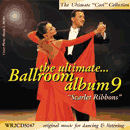Learn to Dance: Swing

The flirtatious, energetic Swing
(Photo: Emerald Ball 2008)
History of Swing - The history of Swing dates back to the 1920's, where the local community in Harlem dancing to contemporary Jazz music, discovered the Charleston and the Lindy Hop. The Lindy Hop was named after American aviator, Charles Lindberg, after his flight across the Atlantic Ocean.
In 1926, the Savoy Ballroom opened its doors in New York. The Savoy was an immediate success and attracted the best dancers and big bands in New York City. Big band greats like Chick Webb, Duke Ellington and Benny Goodman, began creating new musical arrangements. The band leaders discovered that by shifting the accent of the music, from counts 1 and 3, to counts 2 and 4, they created a "swinging" rhythm. The music was called Swinging Jazz and before long the dance became known as the Swing. Later in the 1930s, a bouncy six beat rhythm was dubbed the Jitterbug by band leader Cab Calloway after releasing his popular tune entitled "Jitterbug".
By 1936, the Lindy was sweeping the United States. As might be expected, reaction to the Lindy was met with some criticism. Better establishments frowned upon the wilder, acrobatic forms of the Jitterbug because these movements limited the number of people who could dance at one time. Eventually, teaching organizations were told that the Jitterbug (a direct descendent of the Lindy Hop), could no longer be ignored and could be refined to suit a crowded dance floor.
In early 1938, Dean Collins arrived in Hollywood. He learned to dance the Lindy Hop, Swing and Jitterbug in New York City and spent a lot of time in Harlem and the Savoy Ballroom. In the early 1940's, Dean Collins was leading the action in Southern California night clubs and is considered the innovator of the West Coast Swing.
As the music changed through the years (Jazz, Rock 'n' Roll, Rhythm & Blues) and the single-time beat developed into double and triple-time rhythms, Swing dancing evolved across the U.S. into other regional styles, such as: the Texas Push, the Imperial Swing, Carolina Shag, triple-time East Coast Swing and West Coast Swing.
Today’s Swing allows for adlibbing and complete freedom of expression that can be interpreted into the dance. You will find dancers everywhere adding their own steps and styling into the Swing. These attributes have helped the Swing stand the test of time and it is here to stay.
Music and Tempo - Swing music is written in 4/4 time. Various tempi are used for different styles of Swing. East Coast Swing: 30-34 measures per minute, Lindy Hop: 42-46 measures per minute, West Coast Swing: 28-32 measures per minute.
Style - The Swing is a spot dance not moving along the Line of Dance. Free rhythmic interpretation (adlibbing) is characteristic, using single, double and triple-time rhythms. Steps include an assortment of 6 and 8-beat patterns with various turns and swiveling movements.
| Step | Rhythm & Beats |
Foot Movement |
Footwork | Amt of Turn |
Dance Position |
|---|---|---|---|---|---|
| 1 | Q-1 | LF side | B | Optional- Up to 1/2 turn to right over steps 1-8 |
Closed or Open Dance Position throughout |
| 2 | and | RF close | B fl | ||
| 3 | Q-2 | LF side | B fl | ||
| 4 | Q-3 | RF side | B | ||
| 5 | and | LF close | B fl | ||
| 6 | Q-4 | RF side | B fl | ||
| 7 | Q-5 | LF bk | B (H) | ||
| 8 | Q-6 | RF fwd | B fl | ||
| Definitions - Click here | |||||
| Step | Rhythm & Beats |
Foot Movement |
Footwork | Amt of Turn |
Dance Position |
|---|---|---|---|---|---|
| 1 | Q-1 | RF side | B | Optional- Up to 1/2 turn to right over steps 1-8 |
Closed or Open Dance Position throughout |
| 2 | and | LF close | B fl | ||
| 3 | Q-2 | RF side | B fl | ||
| 4 | Q-3 | LF side | B | ||
| 5 | and | RF close | B fl | ||
| 6 | Q-4 | LF side | B fl | ||
| 7 | Q-5 | RF bk | B (H) | ||
| 8 | Q-6 | LF fwd | B fl | ||
| Definitions - Click here | |||||

 Online Music Store
Online Music Store